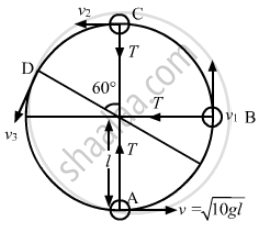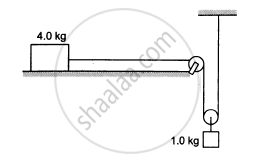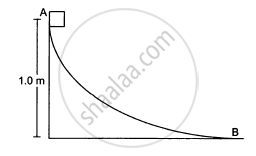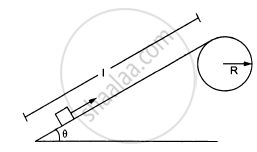Advertisements
Advertisements
प्रश्न
The bob of a pendulum at rest is given a sharp hit to impart a horizontal velocity \[\sqrt{10 \text{ gl }}\], where l is the length of the pendulum. Find the tension in the string when (a) the string is horizontal, (b) the bob is at its highest point and (c) the string makes an angle of 60° with the upward vertical.
उत्तर
(a) Let the velocity at B be \[\text{v}_1\] .
\[\frac{1}{2}\text{ m}\nu^2 = \frac{1}{2}\text{m} v_1^2 + \text{mgl}\]
\[ \Rightarrow \frac{1}{2}\text{m} \left( 10 \text{gl} \right) = \frac{1}{2}\text{m} \nu_1^2 + \text{mgl}\]
\[ \nu_1^2 = 8 \text{gl}\]

So, the tension in the string at the horizontal position,
\[\text{ T }= \frac{\text{ m} \nu^2}{\text{ R}} = \text{ m }\frac{8 \text{ gl} }{\text{l}}\]
\[ = 8 \text{mg}\]
(b) Let the velocity at C be \[\text{v}_2\] .
\[\frac{1}{2}\text{ m }\nu^2 = \frac{1}{2}\text{ m }\nu_2^2 + \text{ mg (2l)}\]
\[\Rightarrow \frac{1}{2}\text{m} 10 \text{ gl } = \frac{1}{2}\text{ m }\nu_2^2 + 2\text{ mgl }\]
\[ \Rightarrow \nu_2^2 = 6 \text{ gl }\]
So, the tension in the string is given by \[T_C = \frac{\text{mv}_2^2}{\text{l}} - \text{mg = 5 mg}\]
(c) Let the velocity at point D be \[\nu_4\] .
Again,
\[\frac{1}{2}\text{m} \nu^2 = \frac{1}{2}\text{m} \nu_3^2 + \text{mgl} \left( 1 + \cos 60^\circ\right)\]
\[ \Rightarrow \nu_3^2 = 7 \text{gl}\]
So, the tension in the string,
\[\text{T}_\text{D} = \frac{\text{m} \nu_3^2}{\text{l}} - \text{mg} \cos 60^\circ\]
\[ = \text{m}\frac{\left( 7 \text{gl} \right)}{\text{l}} - 0 . 5 \text{mg}\]
\[ = 7 \text{ mg - 0 . 5 mg }\]
\[ = 6 . 5 \text{ mg}\]
APPEARS IN
संबंधित प्रश्न
A ball is given a speed v on a rough horizontal surface. The ball travels through a distance l on the surface and stops. what are the initial and final kinetic energies of the ball?
A ball is given a speed v on a rough horizontal surface. The ball travels through a distance l on the surface and stops. What is the work done by the kinetic friction?
The US athlete Florence Griffith-Joyner won the 100 m sprint gold medal at Seoul Olympics in 1988, setting a new Olympic record of 10⋅54 s. Assume that she achieved her maximum speed in a very short time and then ran the race with that speed till she crossed the line. Take her mass to be 50 kg. Calculate the kinetic energy of Griffith-Joyner at her full speed.
The US athlete Florence Griffith-Joyner won the 100 m sprint gold medal at Seoul Olympics in 1988, setting a new Olympic record of 10⋅54 s. Assume that she achieved her maximum speed in a very short time and then ran the race with that speed till she crossed the line. Take her mass to be 50 kg. Assuming that the track, wind etc. offered an average resistance of one-tenth of her weight, calculate the work done by the resistance during the run.
A water pump lifts water from 10 m below the ground. Water is pumped at a rate of 30 kg/minute with negligible velocity. Calculate the minimum horsepower that the engine should have to do this.
A scooter company gives the following specifications about its product:
Weight of the scooter − 95 kg
Maximum speed − 60 km/h
Maximum engine power − 3⋅5 hp
Pick up time to get the maximum speed − 5 s
Check the validity of these specifications.
A block of mass 30 kg is being brought down by a chain. If the block acquires a speed of 40 cm/s in dropping down 2 m, find the work done by the chain during the process.
Consider the situation shown in the following figure. The system is released from rest and the block of mass 1 kg is found to have a speed 0⋅3 m/s after it has descended a distance of 1 m. Find the coefficient of kinetic friction between the block and the table.

A block weighing 10 N travels down a smooth curved track AB joined to a rough horizontal surface (In the following figure). The rough surface has a friction coefficient of 0⋅20 with the block. If the block starts slipping on the track from a point 1⋅0 m above the horizontal surface, how far will it move on the rough surface?

A simple pendulum consists of a 50 cm long string connected to a 100 g ball. The ball is pulled aside so that the string makes an angle of 37° with the vertical and is then released. Find the tension in the string when the bob is at its lowest position.
A simple pendulum of length L with a bob of mass m is deflected from its rest position by an angle θ and released (following figure). The string hits a peg which is fixed at a distance x below the point of suspension and the bob starts going in a circle centred at the peg. (a) Assuming that initially the bob has a height less than the peg, show that the maximum height reached by the bob equals its initial height. (b) If the pendulum is released with \[\theta = 90^\circ \text{ and x = L}/2\] , find the maximum height reached by the bob above its lowest position before the string becomes slack. (c) Find the minimum value of x/L for which the bob goes in a complete circle about the peg when the pendulum is released from \[\theta = 90^\circ \]

A particle slides on the surface of a fixed smooth sphere starting from the topmost point. Find the angle rotated by the radius through the particle, when it leaves contact with the sphere.
Figure ( following ) shows a smooth track which consists of a straight inclined part of length l joining smoothly with the circular part. A particle of mass m is projected up the incline from its bottom. Assuming that the projection-speed is \[\nu_0\] and that the block does not lose contact with the track before reaching its top, find the force acting on it when it reaches the top.

Figure ( following ) shows a smooth track which consists of a straight inclined part of length l joining smoothly with the circular part. A particle of mass m is projected up the incline from its bottom.Assuming that the projection-speed is only slightly greater than \[\nu_0\] , where will the block lose contact with the track?

A man, of mass m, standing at the bottom of the staircase, of height L climbs it and stands at its top.
- Work done by all forces on man is equal to the rise in potential energy mgL.
- Work done by all forces on man is zero.
- Work done by the gravitational force on man is mgL.
- The reaction force from a step does not do work because the point of application of the force does not move while the force exists.
Give example of a situation in which an applied force does not result in a change in kinetic energy.
A raindrop of mass 1.00 g falling from a height of 1 km hits the ground with a speed of 50 ms–1. Calculate
- the loss of P.E. of the drop.
- the gain in K.E. of the drop.
- Is the gain in K.E. equal to a loss of P.E.? If not why.
Take g = 10 ms–2
Suppose the average mass of raindrops is 3.0 × 10–5 kg and their average terminal velocity 9 ms–1. Calculate the energy transferred by rain to each square metre of the surface at a place which receives 100 cm of rain in a year.
